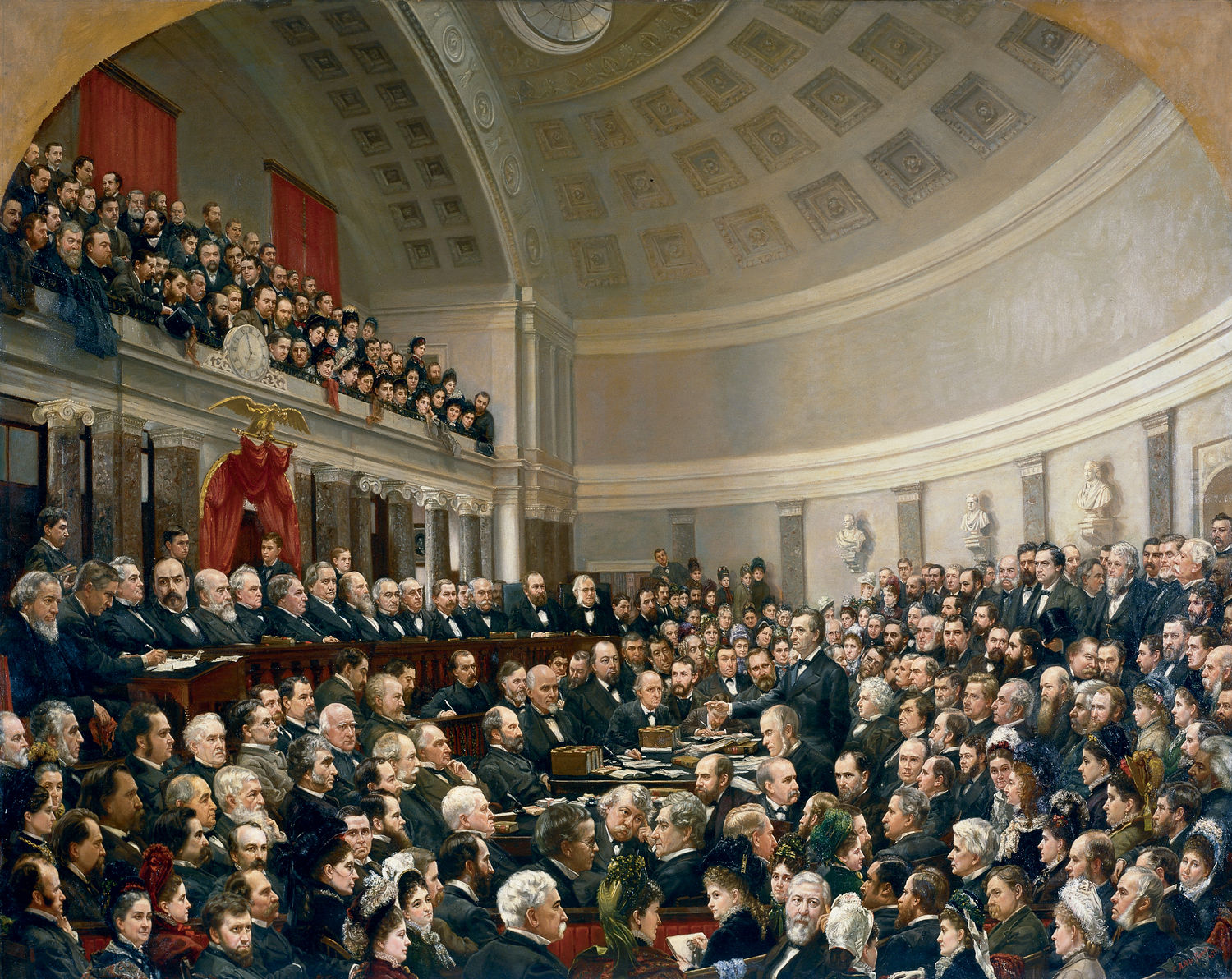
| Title | The Florida Case before the Electoral Commission |
| Artist/Maker | Cornelia Adèle Strong Fassett ( 1831 - 1898 ) |
| Date | 1879 |
| Medium | Oil on canvas |
| Dimensions | Sight: h. 60 x w. 75 in. (h. 152.4 x w. 190.5 cm)
Framed: h. 82.75 x w. 100 x d. 12.5 in. (h. 210.185 x w. 254 x d. 31.75 cm) |
| Credit Line | U.S. Senate Collection |
| Accession Number | 33.00006.000 |
During the summers of 1877 and 1878, well-known portrait painter Cornelia Adèle Fassett was permitted to set up a temporary studio in the U.S. Capitol’s Supreme Court Chamber while the Court was not in session. Her aim was to paint a group portrait of the Electoral Commission’s 1877 meeting in the room. The artist’s recognition of the historic significance of this event merits praise. She deserves attention more for her ambition, however, than for her artistic achievement. The federal government did not commission the painting; Fassett created it independently. That she had to wait seven years before Congress agreed to buy it for $7,500 (much less than her original asking price), and endure public criticism of the painting from newspapers, as well as from the Pennsylvania Academy of the Fine Arts, attests to her determination and endurance. Fassett was a competent painter of miniature portraits and her painting was admired for its realism. But the organizational demands of such an ambitious group portrait taxed her abilities. Compositionally, The Florida Case before the Electoral Commission appears rather stilted.
Fassett’s painting has one significant precedent in American art: Samuel F.B. Morse’s The Old House of Representatives, completed in 1822. That much larger painting shows a similar space, the House Chamber, from the same viewpoint as later selected by Fassett: the left side of the room and slightly above the head level of those on the main floor. This allowed a clear view of many faces. Fassett certainly knew Morse’s painting, because it had recently (1874) been displayed at the Corcoran Gallery of Art in Washington, D.C.
The Morse painting is the masterwork of an excellently trained artist, deft at handling complicated perspective constructions and large groups of figures. Where Morse’s figures form subgroups around a central focus, Fassett crowds most of her figures into receding rows. Even the face meant to attract our attention, William M. Evarts, counsel for Hayes, is nearly lost standing amid a sea of faces.
In fairness, Fassett includes nearly three times as many figures as Morse into a much smaller architectural space, and does so on a much smaller canvas. But Fassett includes virtually every person who was relevant to the political crisis, as well as other prominent figures in the capital city. James G. Blaine, for instance, who had unexpectedly lost the Republican nomination to Hayes, appears at the lower foreground of the picture (below the standing Evarts), his handsome face turned to the viewer. Also present is the banker and art collector William Wilson Corcoran, seen in the row just below the commissioners, fourth from the left. Fassett took some artistic license–-not all of the individuals depicted attended the hearings. Some of the faces were based on existing photographic portraits by Mathew Brady. Several relevant Brady photographs survive, including one of Fassett herself.
Among the 256 persons in Fassett’s painting, more than 60 are women. Some are wives or daughters of political figures; others are professionals. Fassett included 17 female journalists in the press gallery and at least one painter in addition to herself on the main floor, Imogene Robinson Morrell. Morrell, prominently placed directly behind Evarts, had studied in Paris with Thomas Couture, had recently exhibited at the Philadelphia Centennial Exposition, and had settled in Washington, D.C. Morrell’s portrait of John Adams Dix hangs in the Senate. Fassett, in front (right of center), holds her sketchbook, in which she has drawn Evarts’s head.
One of the most prominent professional women in Washington, D.C., at the time was the writer Mary Clemmer Ames. Her just-published Ten Years in Washington: Life and Scenes in the National Capital, as a Woman Sees Them vigorously advocated for woman suffrage and equality. Ames sits in the lower right corner of the painting, looking at the viewer, immediately below the great Frederick Douglass, champion of African American equality. Fassett clearly introduced her own concerns into this document, enlarging its record as a turning point in American political life.
Adèle Fassett was born in upstate New York. She experimented with miniature painting and studied art in Paris. After an early career in Chicago, Fassett moved to Washington, D.C., in 1875, where she painted successful documentary portraits of notable government figures. Her 1876 group portrait of the Supreme Court justices was exhibited at the Philadelphia Centennial Exposition. It is now in the collection of the Supreme Court of the United States, along with her portrait of Chief Justice Morrison R. Waite.